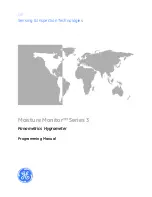
March 2008
1-6
Features and Capabilities
Cabling
Each probe requires an interconnecting cable. Cables differ
depending on the probe. The various cables are discussed below
under the appropriate probe type. All of the cable assemblies can be
ordered from GE Sensing.
IMPORTANT:
See the Calibration Data Sheets, shipped with the
probes, to connect the probes to their corresponding
channels. If a probe is connected to the wrong
channel, the meter will display incorrect data.
IMPORTANT:
To maintain good contact at each terminal block and
to avoid damaging the pins on the connector, pull the
connector straight off (not at an angle), make cable
connections while the connector is away from the
unit, and push the connector straight on (not at an
angle) when the wiring is complete.
M Series and TF Series
Probes
The M and TF Series Probes are connected to the analyzer with a
special GE Sensing shielded cable. Probes can be located up to 600 m
(2000 ft) from the
MMS-3
(consult GE Sensing for distances up to
1,200 m). To measure pressure with a TF Probe, the maximum cable
length is approximately 152 m (500 ft). Small electrical offsets,
especially with longer cables, are possible and should be corrected as
described in
Performing an MH Calibration Test/Adjustment
, in
Chapter 1 of the
Service Manual
.
Delta F Oxygen Cell
The standard Delta F Oxygen Cells are connected to the analyzer with
a four-wire shielded cable (22 AWG). Oxygen cells with a range from
0 to 1/10/100 ppm
v
or 0 to 0.5/5/50 ppm
v
can be located up to 15 m
(50 ft) away from the analyzer. All other oxygen cells can be located
up to 91 m (300 ft) away. Consult GE Sensing for longer cable
lengths.
Pressure Sensors
The
MMS-3
accepts either pressure transducers or pressure
transmitters. Most pressure transducers can be connected with a
standard four-wire shielded cable. Most pressure transmitters are
connected using either a two or four-wire non-shielded cable and can
be either loop- or self-powered.
RS232 Communications
Port
A personal computer or serial printer can be connected to the
MMS-3
RS232 communications port using a standard serial cable. The
MMS-3
has a special switch that enables you to configure the unit as a
Data Terminal Equipment (DTE) or a Data Communications
Equipment (DCE) device. (See Chapter 1 in the
Service Manual
for
details on DTE/DCE configuration.)
Summary of Contents for Moisture monitor series 3
Page 6: ...Chapter 1 ...
Page 15: ...Chapter 2 ...
Page 26: ...Your passcode is 2719 Please remove this page and put it in a safe place for future reference ...
Page 27: ...Chapter 3 ...
Page 78: ...Chapter 4 ...




























